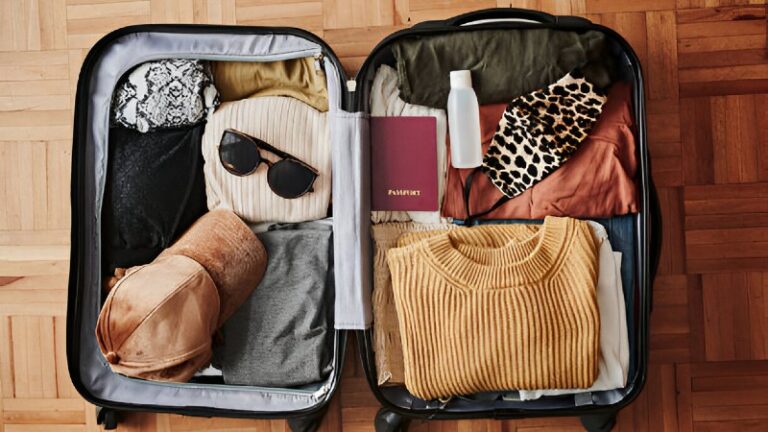Packing for a week-long trip can feel like a logistical nightmare, especially when you’re trying to fit everything into a single carry-on. But with the right strategy, you can travel light, avoid checked baggage fees, and enjoy a stress-free airport experience.
Why Packing Light Matters
Traveling with just a carry-on has several advantages:
- Cost Savings: Avoid expensive checked baggage fees, which can range from $30-$60 per flight for domestic travel and even higher internationally.
- Time Efficiency: Skip long waits at baggage claim and reduce airport stress.
- Mobility: Navigating public transport, stairs, and crowded airports is easier with a single bag.
- Flexibility: Perfect for last-minute flight changes or standby travel.
Quick Statistics
| Aspect | Checked Baggage | Carry-On Only |
|---|---|---|
| Average Cost per Flight | $35-$60 | $0 |
| Average Time Waiting | 20-40 minutes | 0-5 minutes |
| Lost Luggage Risk | 2-3% of passengers | Almost 0% |
Step 1- Choose the Right Carry-On
Not all carry-ons are created equal. Consider these factors:
- Size and Weight: Most airlines allow 22” x 14” x 9” (56 x 36 x 23 cm) as standard. Check your airline’s restrictions to avoid surprises.
- Durability: Hardshell or high-quality softshell bags can withstand repeated handling.
- Compartments: Multiple compartments and compression features help keep items organized and accessible.
- Mobility: Spinner wheels or a comfortable backpack strap make navigating airports easier.
Example: A 20-liter backpack may be sufficient for urban trips, whereas a 40-45 liter wheeled carry-on is better for more outdoor or versatile trips.
Step 2- Plan Your Outfits Strategically
The secret to packing a week’s wardrobe in one carry-on is versatility. Follow these guidelines:
Choose a Color Palette
Pick 2-3 neutral colors (black, gray, navy, beige) and 2-3 accent colors. This allows you to mix and match pieces effortlessly.
Maximize Outfit Options
- 5-6 Tops (shirts, blouses, T-shirts)
- 3-4 Bottoms (pants, skirts, shorts)
- 1-2 Dresses or dressy outfits for evenings
- 1 Outer Layer (light jacket, cardigan, or sweater)
- 1-2 Activewear sets if you plan to exercise or hike
With 6 tops and 3 bottoms, you can create up to 18 different outfit combinations. Adding a dress or dressy outfit increases versatility.
Example Wardrobe Table
| Type | Quantity | Purpose |
|---|---|---|
| Tops | 6 | Day-to-day wear, casual, sightseeing |
| Bottoms | 3 | Mix and match, lightweight and quick-drying |
| Dresses | 1-2 | Dinner or events |
| Outerwear | 1 | Cool evenings or unexpected weather |
| Activewear | 1-2 | Exercise or hiking |
| Swimwear | 2 | Beach or pool days |
Step 3- Pack Smart Using Techniques That Save Space
How you pack your items is just as important as what you pack. Here are advanced methods:
Rolling vs. Folding
- Roll lightweight clothing: T-shirts, leggings, shorts. Rolling reduces wrinkles and saves space.
- Fold heavier items: Sweaters, jackets, khakis. Stack flat to maintain shape.
Packing Cubes and Compression Bags
Packing cubes help categorize your wardrobe (tops, bottoms, activewear, undergarments) and keep your bag organized. Compression bags are perfect for bulky items and separating dirty clothes.
Strategic Layering
Place heavier items at the bottom of your carry-on. Roll smaller items around shoes and fill gaps with accessories or socks.
Step 4- Minimize Shoes and Accessories
Shoes take up the most space. For a week-long trip, stick to:
- Comfortable walking shoes or sneakers
- Sandals or flats
- Optional dress shoes or versatile boots
Place shoes in cloth bags to prevent dirt transfer and tuck socks or underwear inside. Accessories like scarves or jewelry should be stored in compact pouches to keep them untangled.
Step 5- Pack Toiletries Efficiently
Stick to TSA’s 3-1-1 rule: one quart-sized bag, liquids ≤3.4 oz (100 ml).
- Travel-size shampoo, conditioner, body wash
- Toothbrush, toothpaste, floss
- Skincare essentials
- Prescription medications and vitamins
Pro Tip: Use solid alternatives like lotion bars or shampoo bars to save space and avoid liquid restrictions.
Step 6- Plan for Laundry
For week-long trips, you don’t need seven sets of clothes if you can wash midweek:
- Bring a small pack of detergent sheets or pods
- Choose quick-drying fabrics (linen, polyester, nylon)
- Hand wash in the sink and hang-dry overnight
Step 7- Organize Electronics and Documents
Keep valuables in your personal item (backpack or tote) for easy access:
- Laptop, tablet, phone, chargers
- Headphones or earbuds
- Passport, boarding passes, travel insurance
- Cash, credit card, and backup debit card
Tip:
Use small pouches or tech organizers to prevent tangled cords and misplaced items.
Step 8- Create a Day-by-Day Packing Map
Planning outfits for each day reduces overpacking and decision fatigue:
- List each day’s activities and weather expectations
- Assign specific outfits for mornings, afternoons, and evenings
- Include one flexible outfit for unexpected events
This approach ensures you don’t bring unnecessary items, while still keeping variety and style in mind.
Step 9- Optimize Carry-On Accessibility
Keep items you’ll need during the flight or upon arrival at the top or in external compartments:
- Passport, boarding pass, ID
- Medications and essential toiletries
- Change of clothes (just in case your flight is delayed or luggage misplaced)
- Reusable water bottle and snacks
Step 10- Embrace Minimalism and Flexibility
Packing light is more than just space-saving—it’s a mindset:
- Choose versatile items that serve multiple purposes
- Mix and match colors and patterns for variety
- Accept that you may wear certain items multiple times
- Use laundry options strategically to extend wardrobe options
Conclusion
Packing for a week in a carry-on may seem daunting, but with the right planning, techniques, and mindset, it’s completely achievable. From choosing a durable carry-on, creating a strategic wardrobe, and using space-saving techniques, to minimizing shoes, toiletries, and electronics, you can travel light without sacrificing style or comfort.
By embracing this fresh approach focusing on versatility, planning, and organization—you’ll not only save money and time but also enjoy the freedom and flexibility that comes with traveling with just a carry-on.
Pro Tip: After your first carry-on-only trip, you’ll realize how liberating it is. Overpacking becomes a thing of the past, and every future trip feels lighter and more manageable.
Frequently Asked Questions (FAQs)
Can I really fit a week’s worth of clothes in one carry-on?
Yes! With strategic planning, versatile clothing, and smart packing techniques like rolling, folding, and using packing cubes, you can comfortably fit 7 days of clothing and essentials in a standard carry-on.
How many shoes should I pack for a week-long trip?
For a week, pack no more than 3 pairs: comfortable walking shoes, versatile sandals or flats, and one pair of dressy shoes or boots depending on your destination. Wear your bulkiest pair on the plane to save space.
How can I avoid wrinkles when packing in a carry-on?
Roll lightweight items, fold heavier clothing neatly, and use packing cubes or garment bags for delicate items. Bringing a compact travel steamer can help keep your clothes wrinkle-free during the trip.
What toiletries are essential for a carry-on?
Follow the TSA 3-1-1 rule: a quart-sized bag with liquids ≤3.4 oz. Essentials include toothpaste, toothbrush, shampoo/conditioner, body wash, skincare, medications, and small deodorant. Solid alternatives like lotion bars or shampoo bars save space.
How do I plan outfits for a week in a carry-on?
Stick to a color palette of 2-3 neutral colors and 2-3 accent colors. Mix and match tops and bottoms to create multiple outfits. Plan a daily outfit map to minimize overpacking and ensure versatility.
Should I bring laundry detergent for a week-long trip?
Yes, packing a small container of detergent or laundry sheets allows you to wash a few items midweek. Quick-drying fabrics make this convenient and extend your wardrobe without adding bulk.


